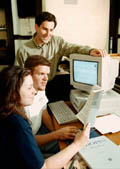Computers Play a New Tune in the Music Classroom

Details
Thanks to various Multimedia Development Grants from the Provost's Office, associate professor of music and music department chair Richard Freedman is one of a growing number of Haverford faculty members who are using computers in their curriculum to change the way their particular subject is taught in the classroom.
"Musicians are well prepared for using computers in the classroom," Freedman explains. "By nature, musical study involves a wide variety of source materials, from printed scores and texts to sound and, of course, live musical performances. New and old technologies from the CD player to the chalk board coexist in the music classroom, which was 'multiple' in its use of media long before the current generation of computers made 'multimedia' something of a household word."
With this new technology, students are able to directly, and almost instantaneously, compare specific movements of different recorded performances. The digital nature of the compact disc recordings are so precise, students can locate and hear moments in different performances to the fraction of a second.
"The idea here is to streamline the process of comparing and contrasting to understand a particular analytical or critical argument about a piece," says Freedman. "The technology lets students get to a specific passage in an immediate way without having to listen to the whole piece or imagining in their musical memories what that passage sounded like."
Students in Freedman's classes are also able to publish their critical papers on the World Wide Web with links that direct the computer to play passages from ordinary compact discs. This allows students to instantaneously "hear" the exact movement they are discussing in their papers.
"That way the reader of the paper hears exactly what the student is talking about, and they are not listening to the composition via their own memory," Freedman explains.
Freedman calls this computer assisted listening technique an "interrogation" of a standard compact disc. So, how are different performance versions of the Chopin Mazurkas standing up to such intense "cyber questioning?"
To the 15 students in Freedman's European Musical Heritage II class, recordings of the Mazurkas by William Kapell, Peter Serkin, Arthur Rubinstein and Ignaz Friedman, it has become clear that Chopin was sending out distinctly different versions of the compositions to publishers in England, France and Germany.
"We look at these different performance artists and we are now able to determine which composition they were using," says Freedman, noting that Serkin, for example, is well aware of the differences among the versions of Chopin's works.
The issue has not only brought to question whether any version can be called "authoritative" but also the idea of variance and the nature of "performance" in musical history. Students have also delved into the marketplace of the period and examined the possibility of its influence on the creation of the three differing compositions, says Freedman.
Freedman's multimedia approach to the classroom also opens up opportunities for members of the public to engage in the scholarship. He notes that web surfers can visit his multimedia pages and, if they have the correct compact discs and a computer with a built-in CD player, can actually listen to the comparisons that are being drawn both in student papers and in classroom discussions.



